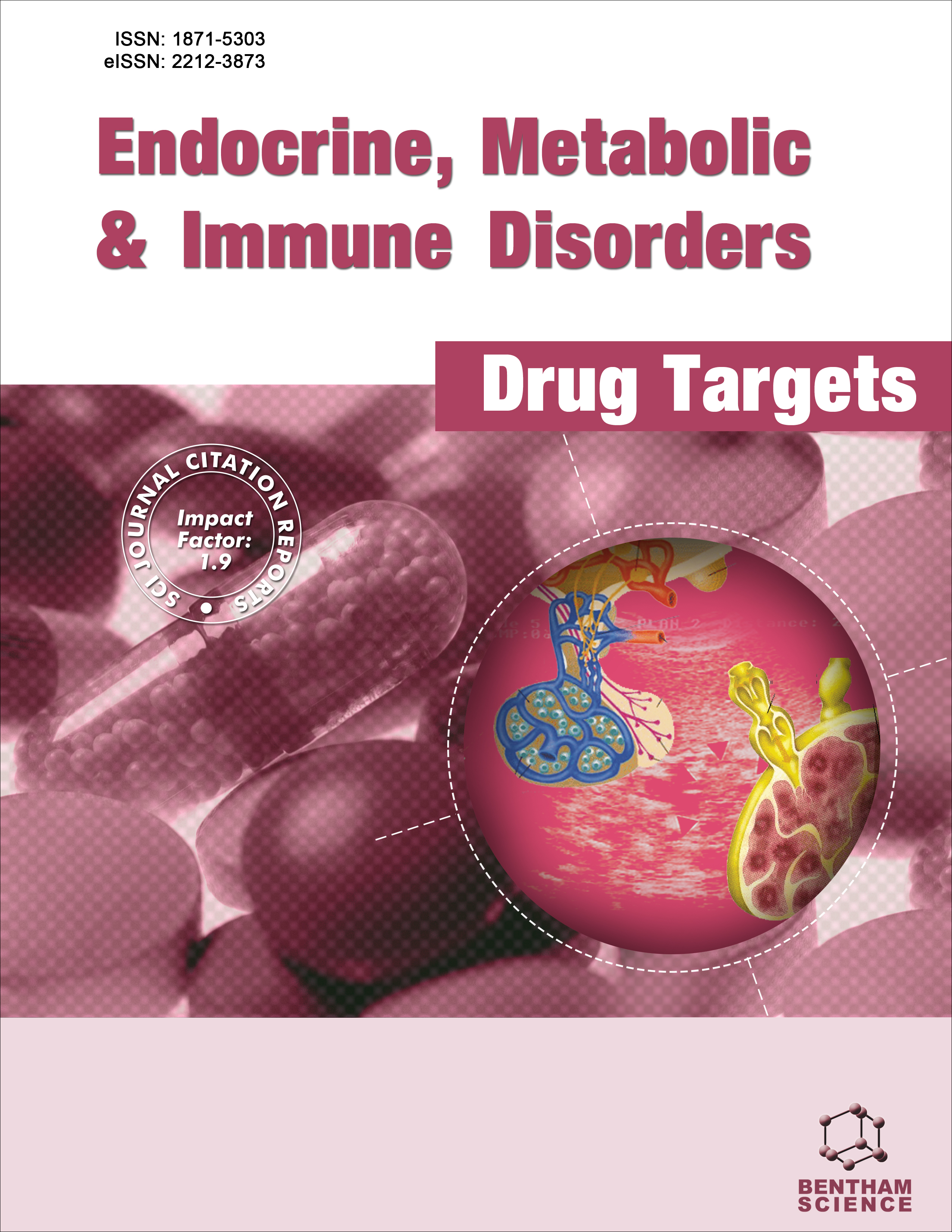- Home
- A-Z Publications
- Endocrine, Metabolic & Immune Disorders-Drug Targets (Formerly Current Drug Targets - Immune, Endocrine & Metabolic Disorders)
- Previous Issues
- Volume 15, Issue 2, 2015
Endocrine, Metabolic & Immune Disorders-Drug Targets (Formerly Current Drug Targets - Immune, Endocrine & Metabolic Disorders) - Volume 15, Issue 2, 2015
Volume 15, Issue 2, 2015
-
-
Drug Targeting Based on a New Concept-Targeting Against TLR4 as an Example
More LessTLRs are very important players to regulate innate immune responses. TLR4 controls the host defense by sensing an exotic pathogen, such as lipopolysaccharides. At the same time, some endogenous proteins, including HMGB1 and S100A8, could also function to be a ligand to elicit inflammatory reactions. These facts make TLR4 signaling system very complicated. For instance, the application of TLR4 ligands in canc Read More
-
-
-
Curcumin Targets in Inflammation and Cancer
More LessCurcumin (1,7-bis(4-hydroxy-3-methoxyphenyl)-1,6-heptadiene-3,5-dione) is commonly used as a spice, food additive or dietary pigment. Accumulating evidence suggests that curcumin has several pharmacologic effects, including anti-inflammatory, anti-oxidant and anti-cancer activities. The molecular mechanisms underlying the targets of curcumin are diverse and involve combinations of multiple signaling path Read More
-
-
-
S100A9 as a Pharmacological Target Molecule in Inflammation and Cancer
More LessAuthors: Tomas Leanderson, David Liberg and Fredrik IvarsUpon tissue injury and infection both stressed and dying cells can release proteins that normally reside inside the cells. Some of the released proteins become ligands of various cell surface receptors expressed by local cells and such proteins are denoted as damage associated molecular patterns (DAMPs). Binding of some DAMPs to certain cell surface receptors induces signals emanating in the production of pro-inflamma Read More
-
-
-
CCL2-CCR2 Signaling in Disease Pathogenesis
More LessAuthors: Tracy O’Connor, Lubor Borsig and Mathias HeikenwalderThe role of chemokines and their receptors in controlling several physiological and pathological processes has only become evident in the last couple of years. From a sole function of chemo-attraction, our view on chemokine receptor activation has switched to the regulation of pleiotropic signaling pathways influencing numerous molecular and cellular processes. The large number of chemokines and receptors and hence Read More
-
-
-
Eph as a Target in Inflammation
More LessEvidence to show that the Eph/ephrin system is involved in inflammation induced by infection, injury, inflammatory diseases, and atherosclerosis has been increased. Although the roles of the Eph/ephrin system in both neural and vascular development as well as cell motility are well documented, its involvement in inflammatory processes has not yet been elucidated in detail. Moreover, the soluble form of artificially o Read More
-
-
-
TNF as a Target of Inflammation in Rheumatoid Arthritis
More LessAnti-Tumor Necrosis Factor (TNF) agents were the first molecular targeting drugs developed for the treatment of rheumatoid arthritis (RA). Anti-TNF agents improve the clinical picture of severe RA patients, inhibit joint destruction and improve quality of life. In the 15 years since their introduction, they have become the preferred drug therapy for management of RA. The success of anti-TNF agents in the treatment of RA has resulte Read More
-
-
-
VEGF-VEGFR System as a Target for Suppressing Inflammation and other Diseases
More LessThe vascular endothelial growth factor (VEGF)-VEGF receptor (R) system is deeply involved in angiogenesis and lymphangiogenesis. VEGFR1/ Fms-like tyrosine kinase-1 (Flt-1) and VEGFR2 are significantly expressed in vascular endothelial cells, where they transfer proangiogenic signals. Particularly, VEGFR2 has strong tyrosine kinase activity; thus, the major and direct angiogenic signals are generated from VEGFR2. VEGF Read More
-
-
-
Adiponectin as a Target in Obesity-related Inflammatory State
More LessAuthors: Koji Ohashi, Daisuke Yuasa, Rei Shibata, Toyoaki Murohara and Noriyuki OuchiAccumulating evidence indicates that low grade inflammation is closely associated with obesity-related disorders including type 2 diabetes, hypertension and atherosclerosis. Adiponectin is a fat-derived plasma protein with anti-inflammatory functions. Circulating levels of adiponectin are decreased in obese states, and these conditions are broadly associated with various obesity-related diseases. Furthermore, adiponectin Read More
-
-
-
Thalidomide Controls Adipose Tissue Inflammation Associated with High- Fat Diet-Induced Obesity in Mice
More LessIntroduction: Immunosuppressant agents modulate the activity of the immune system and control adipose tissue inflammatory responses associated with obesity. Controlling adipose tissue inflammation represents an interesting option for inhibiting the low-grade inflammatory state in obese subjects and for preventing obesity-associated pathologies. In this work, we assessed the effects of thalidomide on the inflammat Read More
-
-
-
Fluoroquinolone and Ovariectomy in the Bitch: Physiology of the Immune System as to CD56 and CD16 Expression
More LessNatural killer (NK) cells are innate lymphoid cells which act against a variety of pathogens and tumours. Phenotypically they are characterized by surface markers named cluster designation (CD) antigens. CD56 and CD16 are recognized as specific NK markers in the dogs as well as in humans. Surgical interventions suppress NK cells both in rats and humans. In this direction, it has been shown that an antibiotic regimen (amoxicil Read More
-
Volumes & issues
-
Volume 25 (2025)
-
Volume 24 (2024)
-
Volume 23 (2023)
-
Volume 22 (2022)
-
Volume 21 (2021)
-
Volume 20 (2020)
-
Volume 19 (2019)
-
Volume 18 (2018)
-
Volume 17 (2017)
-
Volume 16 (2016)
-
Volume 15 (2015)
-
Volume 14 (2014)
-
Volume 13 (2013)
-
Volume 12 (2012)
-
Volume 11 (2011)
-
Volume 10 (2010)
-
Volume 9 (2009)
-
Volume 8 (2008)
-
Volume 7 (2007)
-
Volume 6 (2006)
Most Read This Month
Article
content/journals/emiddt
Journal
10
5
false
en


